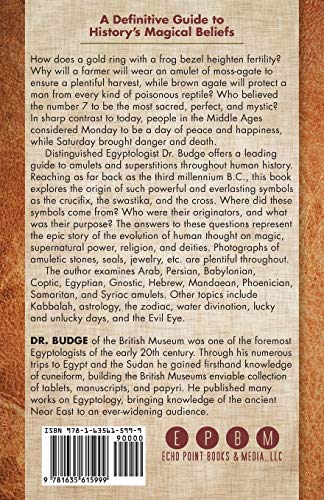Customer Services
Copyright © 2025 Desertcart Holdings Limited
Desert Online General Trading LLC
Dubai, United Arab Emirates



Amulets and Superstitions: The Original Texts With Translations and Descriptions of a Long Series of Egyptian, Sumerian, Assyrian, Hebrew, Christian
A**R
Any occult book by Dover, in fact anything Dover ...
Any occult book by Dover, in fact anything Dover publishes is fascinating. E Wallis Budge puts things in such a way as to educate and entertain simultaneously, reminds me of Arthur Conan Doyle some what. I'm trying to collect and read them all.
C**E
Four Stars
good reading
C**N
the power of symbols
Good book I find his views on the swastika somewhat equal to that of Thomas Wilson book Swastika and how sick evil people like Adolph Hitler and his Nazis can use ancient symbols to poison and enslave the minds of the population and it's victims.
W**.
Middle East Amulets
By Sir Budge, (1857-1934), curator of the Egyptian Antiquities in the British Museum, who also translated the "Egyptian Book of the Dead." From the book's preface: "I have described the principal amulets which were used by the Semitic peoples of Western Asia, Egypt, Nambia and Ethiopia. I have added a series of short chapters in which I have tried to set forth the principal theories about the powers of 'working' amulets, and the meaning of the inscriptions and symbols inscribed on them, and to indicate the beliefs concerning them which were held by the ancient Babylonian and Egyptian magicians, and by the later Kabbalists, Gnostics, both pagan and Christian, and astrologers. And I have incorporated in the many of the views of the astrologers, makers of horoscopes, casters of nativities, diviners, crystal gazers, palmists and fortune-tellers with who I came in contact in Egypt, the Sudan and Mesopotamia." The author discusses: the Evil Eye, and amulets used by: Arabs, Persians, Babylonians, Coptics, Egyptians, Abyssinians, Gnostic, Hebrew, Mandaeen, Phoenician, Samaritan, Syriac; the Ring amulet; beliefs concerning Divination by water or animal's livers or sand; the Hand of Fatima; Babylonian demon Humbaba, god Khepera, Rd, Thoth; the Seven Seals; and much, much more. Many photographs and illustrations. Originally published in 1930.
W**.
Superstitions in the Middle East
By Sir Budge, (1857-1934), curator of the Egyptian Antiquities in the British Museum, who also translated the "Egyptian Book of the Dead." From the book's preface: "I have described the principal amulets which were used by the Semitic peoples of Western Asia, Egypt, Nambia and Ethiopia. I have added a series of short chapters in which I have tried to set forth the principal theories about the powers of 'working' amulets, and the meaning of the inscriptions and symbols inscribed on them, and to indicate the beliefs concerning them which were held by the ancient Babylonian and Egyptian magicians, and by the later Kabbalists, Gnostics, both pagan and Christian, and astrologers. And I have incorporated in the many of the views of the astrologers, makers of horoscopes, casters of nativities, diviners, crystal gazers, palmists and fortune-tellers with who I came in contact in Egypt, the Sudan and Mesopotamia." The author discusses: the Evil Eye, and amulets used by: Arabs, Persians, Babylonians, Coptics, Egyptians, Abyssinians, Gnostic, Hebrew, Mandaeen, Phoenician, Samaritan, Syriac; the Ring amulet; beliefs concerning Divination by water or animal's livers or sand; the Hand of Fatima; Babylonian demon Humbaba, god Khepera, Rd, Thoth; the Seven Seals; and much, much more. Many photographs and illustrations. Originally published in 1930; paperback in 1978.
R**O
A paragon
B was a phenomenon, an originally self-taught person who had a remarkable grasp of many difficult languages.He wrote prodigiously and well. it is useful that B was a bit of a believer in the occult: despite the title, he did not reject superstitions and recognized their role in daily life. the array of material surveyed is staggering. B always moved with confidence. readers should note that new data, editions, versions, and studies have altered some of the views.expressed. B was, however, always fair and never judgmental. his mode of acquisition is no longer in favor. by the standards of that day he was fair, always paying and never simply plundering. this survey shows the continuity of belief in minor practices, from Sumer to this day. superstitions are durable, as this old book.
R**Y
Deeply informative
This book contains much more information than I could take in on one read. Anyone who is interested in the magical beliefs of ancient civilizations will find this book extremely interesting.
Trustpilot
3 weeks ago
1 month ago